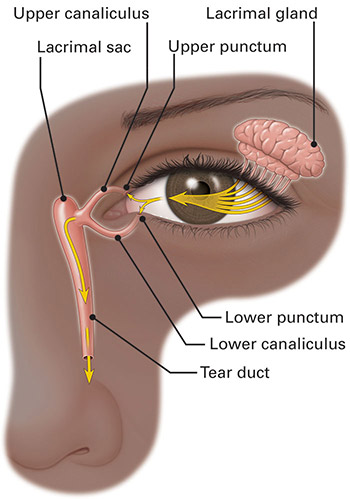Many people suffer from dry eye, when their eyes do not make enough tears or the right quality of tears. Eye drops are often used to treat dry eye. However, some people find that having punctal plugs inserted into their eyelids can help make their eyes more comfortable.
What Are Punctal Plugs?
Punctal plugs are tiny devices that are placed in the eye’s tear ducts (called puncta). Puncta are the tiny openings in your eyelids that drain tears from your eyes. The plug is about the size of a grain of rice, and it blocks tears from draining from the eye. This helps keep the eye’s surface moist and comfortable, relieving itchy, burning and red eyes.

Punctal plugs are also called punctum plugs, lacrimal plugs or occluders. Usually they are inserted in the puncta of the upper or lower eyelids, or in both. Another type of plug is placed in a deeper part of the tear duct (the canaliculus).
Two Types of Punctal Plugs
Temporary/dissolving plugs
These are made of a material (such as collagen) that gradually breaks down and is absorbed by the body. These plugs can last in the eye from a few days to months. Temporary plugs are often used to keep the eye moist after having refractive surgery, such as LASIK. They are also used when you want to try out punctal plugs to see if they help relieve your dry eye.
Semi-permanent plugs
These are made of a longer-lasting medical plastic (such as silicone or acrylic). These plugs are designed to stay in the eyelid for years. They can be removed by your ophthalmologist if needed.
Another type of semi-permanent punctal plug is placed in a deeper part of the tear duct called the canaliculus. These plugs cannot be seen at all in the eye.

A punctal plug placed in the eyelid treats dry eye by conserving your eye's natural tears.
How Are Punctal Plugs Inserted?
First your eye doctor will examine your eye to figure out the best type and size plug for your needs.
Your doctor may numb your tear ducts with anesthesia. In some cases, you may not need to have your eyes numbed. You may feel some pressure as the punctal plug is placed in your eyelid.
After the plugs are inserted, you are usually able to return to your normal activities right away.
Punctal Plug Possible Risks and Side Effects
As with any treatment or procedure, punctal plugs can have possible risks and side effects.
The most common side effect is having a scratchy or irritating feeling in the corner of your eye. Many people find this feeling goes away or they simply get used to it.
Other side effects and risks may include the following:
- Punctal plugs might make your eyes watery with too many tears. Your plugs may need to be taken out, or they may be replaced with a different type for better tear control.
- Plugs may move or come out of the eye, usually from rubbing your eyes.
- Plugs that don’t fit properly could stick out of the tear duct and rub against the surface of your eye or eyelid.
- Sometimes punctal plugs can irritate the tear ducts. The plugs may cause redness and swelling (inflammation) in the tear duct. Ongoing inflammation can scar or damage the tear ducts.
- Some types of eye infections can occur, though rarely. Some infections may need to be treated with antibiotics. Your eye doctor may want to remove the plugs.
When and How are Punctal Plugs Removed?
Most people find punctal plugs do not cause any problems. However, side effects can happen. If you feel any eye pain, scratchiness or if you think you have an eye infection, tell your eye doctor right away. They may choose to remove the plugs.
How the plugs are removed depends on which type you have. To remove silicone plugs, your eye doctor will use forceps to gently pull the plugs from the tear duct. Another way to remove these plugs is by flushing them out with a salt water solution. This method forces the plugs out of the tear ducts into the nose or throat.
Plugs that are deeper in the tear duct (in the canaliculus) are removed with surgery.
Are Punctal Plugs for You?
If artificial tears or other eye drops have not relieved your dry eye symptoms, talk with your ophthalmologist. They may recommend trying punctal plugs.